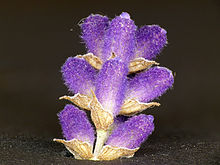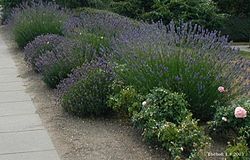- Lavandula angustifolia
-
Lavandula angustifolia 
Common Lavender (Lavandula angustifolia) Scientific classification Kingdom: Plantae (unranked): Angiosperms (unranked): Eudicots (unranked): Asterids Order: Lamiales Family: Lamiaceae Genus: Lavandula Species: L. angustifolia Binomial name Lavandula angustifolia
Mill.[1]Synonyms Lavandula angustifolia (also Lavandula spica or Lavandula vera; common lavender, true lavender, narrow-leaved lavender or English lavender (though not native to England); formerly L. officinalis) is a flowering plant in the family Lamiaceae, native to the western Mediterranean region, primarily in the Pyrenees and other mountains in northern Spain.
Contents
Growth
It is a strongly aromatic shrub growing to 1–2 m tall. The leaves are evergreen, 2–6 cm long and 4–6 mm broad. The flowers are pinkish-purple (lavender-coloured), produced on spikes 2–8 cm long at the top of slender, leafless stems 10–30 cm long.
Etymology
The species name angustifolia is Latin for "narrow leaf". The genus name Lavandula simply means lavender. Previously, it was known as Lavandula officinalis, Latin for "official lavender" or "true lavender", which is one of its common names. This indicated it was the official medicinal lavender.
Cultivation
English lavender is commonly grown as an ornamental plant. It is popular for its colourful flowers, its fragrance and its ability to survive with low water consumption. It does not grow well in continuously damp soil. It is fairly tolerant of low temperatures, generally considered hardy to USDA zone 5.[2]
Uses
In addition to its use as an ornamental plant, the flowers and leaves are also used as an herbal medicine, either in the form of lavender oil or as an herbal tea. The flowers are also used as a culinary herb, most often as part of the French herb blend called herbes de Provence.
Lavender essential oil, when diluted with a carrier oil, is commonly used as a relaxant with massage therapy. Products for home use, such as lotions, eye pillows (including lavender flowers or the essential oil itself) and bath oils, etc., are also used to induce relaxation. Both the petals and the oil are the most popular ingredients in handmade soap.
Dried lavender flowers and lavender essential oil are also used as a prevention against clothing moths, which do not like their scent.
Classification
Often considered to have three groups, separation is based on growth height characteristics - dwarf, semidwarf, and tall (giant) varieties.
Subspecies
Cultivars
Dwarf
Compacta, Folgate, Dwarf Blue, Dwarf White, Hidcote Pink, Hidcote Superior, Munstead, Nana Atropurpurea, Nana Rosea, Sarah, Summerland Surpreme, Lady Lavender
- 'Hidcote Superior', a compact evergreen shrub 16”x18” with fragrant gray-green foliage and deep violet-blue flowers in summer, prefers full sun, well drained soil, low water, hardy to -20°F, western Mediterranean species
- 'Munstead' (syn. Dwarf Munstead, Munstead Blue and Munstead Variety) L. angustifolia variety, 12" tall, having pink-purple to lavender-blue inflorescences that are slightly fragrant,[3] named after Munstead Wood in Surrey, which was the home of Gertrude Jekyll
- 'Sarah', grows to 6-24 in, the flowers are petite, as is the plant, used as a short edging, or as a very fragrant addition to the window box, dark violet flowers
- 'Lady Lavendar', grows to 18 in, fragrant, gray-green foliage and lavender-blue flowers in summer, prefers full sun, well-drained soil, low water, hardy to –20°F
Semidwarf
Bowles Early, Hidcote Variety, Loddon Blue, Martha Roderick, Jean Davis, Twickle Purple, Pink Perfume
- 'Hidcote' (syn. Hidcote Variety, Hidcote Blue, Hidcote Purple) L. angustifolia variety. 15" to 20" tall, with silver-gray foliage and deep violet-blue inflorescences, named after Hidcote Manor in England as it was cultivated there by Major Lawrence Johnston
- 'Jean Davis' 20-24" tall, up to 3ft. A pale pink flowered lavender with exceptionally fruity taste
- 'Pink Perfume' 24" x 18"
Giant
Alba, Blackhouse Purple, Biostos, Bridestowe, Graves, Gray Lady, Gwendolyn Anley, Hidcote Giant, Irene Doyle, Mailette, Middachten
- 'Hidcote Giant'. A Lavandula x intermedias lavandin. Very vigorous grower (36 - 40 inches) with a lovely strong fragrance. This has large deep Lavender-purple flowers on very long 24 inch stems.
- 'Vera' 30-36". Thought to be the original species lavender, harvested for its oil.
Hybrids
Lavandula hybrids are referred to as lavandins. Hybrids between L. angustifolia and L. latifolia are called Lavandula x intermedia. They bloom later than the ordinary English lavendars.
See also
References
- ^ a b c d e f g "Lavandula angustifolia information from NPGS/GRIN". www.ars-grin.gov. http://www.ars-grin.gov/cgi-bin/npgs/html/taxon.pl?21677. Retrieved 2008-04-12.
- ^ USDA Plant Hardiness Zone Map. Retrieved on 2008-05-22.
- ^ Ohio State University: Lavandula
External links
- Lavender fields in the Provence
- Lavandula angustifolia List of Chemicals (Dr. Duke's Databases)
- Lavandula angustifolia Plants for a Future
- Everything lavender
Categories:- Lavandula
- Flora of the Mediterranean
- Flora of Spain
- Garden plants of Europe
- Drought-tolerant plants
- Flowers
- French cuisine
- Herbs
- Incense
- Medicinal plants
- Plants used in Traditional Chinese medicine
Wikimedia Foundation. 2010.






